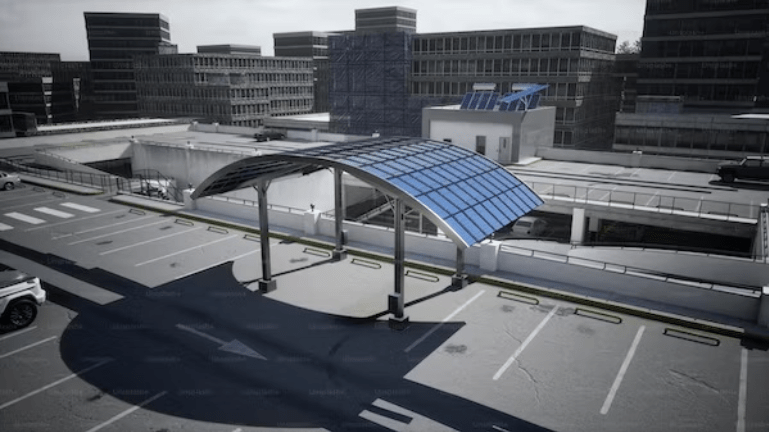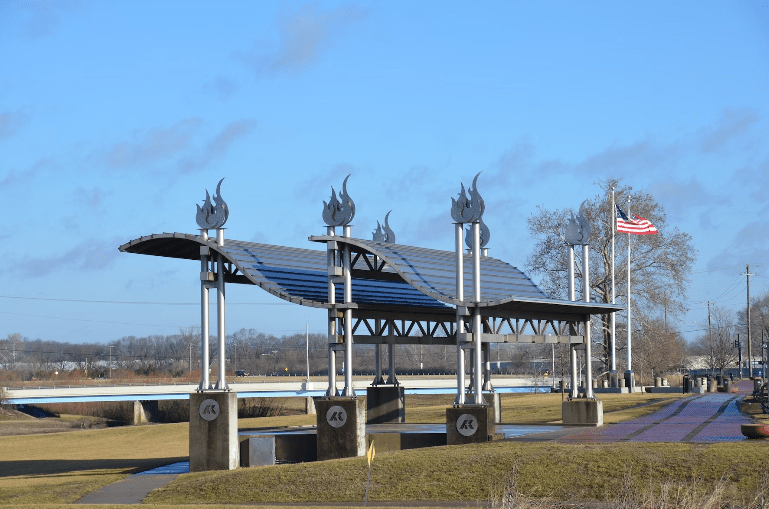
Solar bus stops are revolutionizing urban transit, with a grand role in steering cities towards carbon neutrality. These innovative stops harness solar power to fuel their operations, significantly slashing emissions. They stand as tangible examples of sustainable infrastructure, actively reducing environmental impact. As technology advances, solar bus stops contribute to carbon neutrality more and more notably. This article goes into their substantial benefits and how they present a crucial step towards a greener, more sustainable future.
What Are Solar Bus Stops?
Solar bus stops are transit hubs equipped with solar panels that capture sunlight and convert it into electricity. These stops usually feature a shelter for passengers, often fitted with seating and digital displays for bus schedules. Their primary function is to provide a waiting area for commuters while integrating renewable energy sources into urban infrastructure. The solar panels atop these stops generate power that can be used for lighting, digital signage, and even charging stations for electronic devices.
Their key benefit lies in their ability to operate independently from the conventional power grid. As such, they reduce reliance on non-renewable energy sources and minimize their environmental impact. Moreover, they offer a practical solution by utilizing clean energy to enhance transit while contributing to a more sustainable future.

Impact on Urban Development
With the above in mind, their impact on urban development is tremendous. Solar bus stops contribute to carbon neutrality by themselves, as we’ll see next, and also align with broader sustainability initiatives.
Alignment with Solar Energy Initiatives
For one, solar bus stops share similar technological foundations with solar streetlights. They also share parallel benefits in renewable energy utilization within urban landscapes.
Both systems rely on solar panels to generate electricity, contributing to reducing carbon footprints in their respective functions. Solar bus stops provide clean energy for transit needs, and solar street lights illuminate public spaces, synergistically amplifying the impact of renewable energy in urban areas. This alignment towards sustainable practices fosters carbon neutrality and environmental preservation.
A pioneering force in solar street lights in the US, EnGoPlanet, recognizes and values the synergy between these technologies. They point out that by integrating solar-powered infrastructure like bus stops and street lights, cities can significantly reduce reliance on non-renewable energy sources. This harmonized approach serves as a tangible demonstration of the potential for solar energy to revolutionize and advance environmental goals.
Enhancing Urban Landscapes
Solar bus stops significantly enhance urban landscapes, offering both aesthetic and functional advantages. These stops seamlessly blend into the cityscape, often designed with modern, sleek structures that complement surrounding environments. Beyond their visual appeal, they also serve a practical purpose by providing commuters with shelter, seating, and information displays. As they do, solar bus stops also contribute to carbon neutrality – as we’ll see in more detail next.
Moreover, incorporating solar panels into the design adds a futuristic and eco-friendly element to the urban setting. Solar bus stops demonstrate a commitment to sustainable practices by seamlessly integrating sustainable infrastructure into city design. In doing so, they enhance the overall quality and functionality of public spaces for city dwellers and visitors alike.

Community Engagement and Awareness
Finally, solar bus stops are crucial in fostering community support for sustainable initiatives within urban areas. By serving as visible symbols of eco-friendly practices, these stops prompt awareness and engagement among community members. Their presence showcases the integration of renewable energy and encourages a shift towards more environmentally conscious behaviors.
In brief, people witnessing solar-powered infrastructure in their daily commute are more likely to recognize the importance of sustainable practices. This visibility sparks conversations and educates individuals about the benefits of sustainable transportation and its role in reducing carbon footprints. These stops are tangible examples of how communities can actively contribute to a greener future. They do so by promoting a sense of ownership and pride among residents for being part of a greener city.
How Solar Bus Stops Contribute to Carbon Neutrality
So, how exactly do solar bus stops achieve their main goal of reducing carbon emissions and achieving carbon neutrality? They do so by fundamentally altering the way energy is sourced for transit infrastructure.
These stops harness solar energy, a clean and renewable resource, to power their operations, reducing reliance on fossil fuels. Unlike traditional bus stops, which often rely on electricity sourced from non-renewable grids, solar-powered stops generate their electricity sustainably, resulting in substantially lower commute carbon emissions.
When comparing the carbon footprint of traditional stops reliant on grid power to solar-powered counterparts, the difference is blatant. Solar bus stops produce minimal emissions during their operation since they tap into an eco-friendly energy source. This reduction in emissions directly contributes to efforts aimed at achieving carbon neutrality within urban transportation networks. By adopting solar energy in transit infrastructure, cities can substantially mitigate their carbon footprint. As they do, they’re aligning with global initiatives to combat climate change and work towards a more sustainable future.

Other Advantages of Solar Bus Stops
Their advantages don’t stop there. Indeed, solar bus stops offer several additional advantages beyond reducing carbon emissions:
- Energy Efficiency and Sustainability: These stops harness solar energy, promoting sustainable infrastructure. By utilizing renewable sources, they ensure long-term cost savings and reduced maintenance expenses. Solar power helps minimize reliance on non-renewable energy, contributing to a more sustainable urban environment while cutting operational costs.
- Reduced Costs: Relying less on traditional power sources also translates to significant cost savings. Solar-powered stops operate independently, lowering electricity bills and reducing expenses associated with energy consumption. Over time, these savings accumulate, making solar bus stops a cost-effective alternative to conventional stops powered by grid electricity.
- Future Prospects and Sustainability Goals: Integrating solar-powered infrastructure presents an opportunity for widespread adoption in transit systems. The success of these stops sets the stage for expanding solar-powered initiatives within urban areas. As cities prioritize sustainability goals, the potential for implementing more solar bus stops grows.
Conclusion
Solar bus stops are exemplary models of sustainability in urban transit. Their integration of solar energy minimizes carbon emissions and sets a precedent for eco-friendly infrastructure. Reducing reliance on non-renewable power sources, solar bus stops contribute to carbon neutrality and pave the way for cleaner and more efficient transit systems. As cities worldwide seek innovative solutions to combat climate change, the role of solar bus stops becomes increasingly evident.
